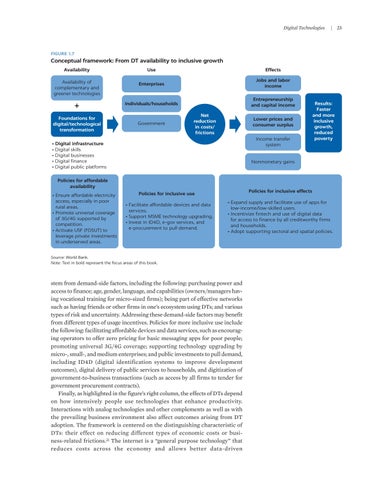Digital Technologies
|
FIGURE 1.7
Conceptual framework: From DT availability to inclusive growth Availability
Use
Effects
Availability of complementary and greener technologies
Enterprises
Jobs and labor income
Individuals/households
Entrepreneurship and capital income
Foundations for digital/technological transformation
Government
Net reduction in costs/ frictions
Lower prices and consumer surplus Income transfer system
• Digital infrastructure • Digital skills • Digital businesses • Digital finance • Digital public platforms
Nonmonetary gains
Policies for affordable availability • Ensure affordable electricity access, especially in poor rural areas. • Promote universal coverage of 3G/4G supported by competition. • Activate USF (FDSUT) to leverage private investments in underserved areas.
Results: Faster and more inclusive growth, reduced poverty
Policies for inclusive effects
Policies for inclusive use • Facilitate affordable devices and data services. • Support MSME technology upgrading. • Invest in ID4D, e-gov services, and e-procurement to pull demand.
• Expand supply and facilitate use of apps for low-income/low-skilled users. • Incentivize fintech and use of digital data for access to finance by all creditworthy firms and households. • Adopt supporting sectoral and spatial policies.
Source: World Bank. Note: Text in bold represent the focus areas of this book.
stem from demand-side factors, including the following: purchasing power and access to finance; age, gender, language, and capabilities (owners/managers having vocational training for micro-sized firms); being part of effective networks such as having friends or other firms in one’s ecosystem using DTs; and various types of risk and uncertainty. Addressing these demand-side factors may benefit from different types of usage incentives. Policies for more inclusive use include the following: facilitating affordable devices and data services, such as encouraging operators to offer zero pricing for basic messaging apps for poor people; promoting universal 3G/4G coverage; supporting technology upgrading by micro-, small-, and medium enterprises; and public investments to pull demand, including ID4D (digital identification systems to improve development outcomes), digital delivery of public services to households, and digitization of government-to-business transactions (such as access by all firms to tender for government procurement contracts). Finally, as highlighted in the figure’s right column, the effects of DTs depend on how intensively people use technologies that enhance productivity. Interactions with analog technologies and other complements as well as with the prevailing business environment also affect outcomes arising from DT adoption. The framework is centered on the distinguishing characteristic of DTs: their effect on reducing different types of economic costs or business-related frictions.21 The internet is a “general purpose technology” that reduces costs across the economy and allows better data-driven
25



